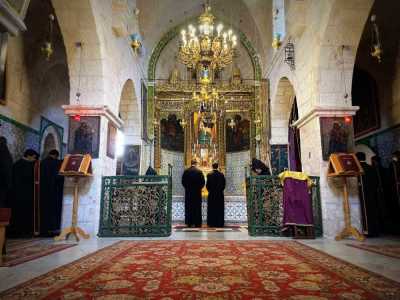Armenians, too, have a formidable history in the Holy Land

In 1894, the American archeologist Frederick J. Bliss made a seminal discovery: a richly decorated sixth-century mosaic from an Armenian mortuary chapel dating to the Byzantine period. Discovered in Musrara, a few hundred meters from the Damascus Gate of the Old City of Jerusalem, it is the only intact mosaic ever found outside Armenia proper with Armenian inscriptions — which in turn are the oldest examples of Armenian writing to have survived over the centuries.
I am reminded of these startling facts as I reflect on the controversy raging over the sale of the “Cow’s Garden” in the Old City of Jerusalem, which has stirred up Armenian anger amid charges of corruption, and in turn has agitated Jewish radicals against Armenians. As an Armenian born and raised in the Old City of Jerusalem (now teaching at the University of Nebraska-Lincoln), I feel compelled to set the record straight, for things are much misunderstood.
I think many would be surprised to learn not only of the profundity of the Armenian presence in the Holy Land, but of how many similarities there are between both peoples, being diasporic groups scattered around the globe in the course of history that suffered the most horrendous genocides of the 20th Century: The Armenian Genocide (1915-1923) and the Shoah (1941-1945).
Even though the Holy Land was never part of Historic Armenia, our historical roots here are deep; our place should be not only protected but cherished.
The first recorded Armenian pilgrimage to the Holy Land occurred in the early 4th century AD when a delegation of priests arrived in the Holy City. When Anastas Vartabed Akoretsi (c. 636-650) visited Jerusalem several centuries later, he could already count 70 monasteries in and around Jerusalem built by Armenians (as well as Caucasian Albanians).
Such archeological and historical facts attest to the connection of Armenians to the Holy Land and the Old City of Jerusalem in particular. Indeed, outside historic Armenia, the Armenian presence in Jerusalem is the oldest. Our community uses the term “Armenian Jerusalem” due to the solid historical presence of the Armenian Patriarchate as well as of the lay community, the core of which are the descendants of those first Armenian pilgrims.
In a way, Jerusalem can be viewed as the most important religious and cultural center in Armenian history. Armenian kingdoms and principalities in historical Armenia fell one after another, the last being the Cilician Kingdom (1098-1375). That left only today’s small rump state in the South Caucasus, whose borders were defined by the Soviet Union. But our corner of Jerusalem remained intact.
Over the centuries, it survived many rulers: Roman, Byzantine, Persian, Arab, Crusaders, Ayyubids, Mamluks, Ottomans, British, and Jordanians. Despite political upheavals in the region, “Armenian Jerusalem” persevered.
The Armenian Patriarchate of Jerusalem in its present form came into being in the first decade of the 14th century when the Brotherhood of St. James was founded. Today, it shares guardianship of Christianity’s holy sites — including the Church of the Holy Sepulcher and the Church of the Nativity — with the Greek Orthodox and Latin (Roman Catholic) churches.
This critical function helps explain the resilience of the Armenians in Jerusalem. Of all the “Little Armenias” scattered not around the world, the one in Jerusalem is perhaps the most authentic — driven by its role for all Christendom and symbolized by the physical presence of countless cultural treasures.
The beautiful Church of St. James, the Convent of Holy Archangels, and the Church of St. Toros are spiritual and artistic gems. The Patriarchate houses 4,000 manuscripts, considered as the second-largest collection of Armenian manuscripts outside Armenia. The Gulbenkian Library in Jerusalem is regarded as the largest Armenian library outside Armenia, housing more than one hundred thousand books. The Mardigian Museum contains the most important artifacts, detailing the history of the Armenians of Jerusalem.
The Armenian Patriarchate has also played a dominant role in resurrecting the Armenian nation from the brink of extinction. It housed and fed thousands of refugees who survived the 1915 Armenian Genocide perpetrated by the Ottomans and established orphanages in the Armenian Cathedral and other nearby places. Some stayed on, enriching the Armenian community here. Community members excelled in photography, ceramics, goldsmith, and silversmith, among other professions.
The community began a dramatic decline due to the 1948 and 1967 wars when many Armenians lost their homes and businesses in West Jerusalem as well as other areas in Israel. Sadly, for decades, spitting and harassing Armenian priests has become the norm among some within the Ultra-Orthodox community.
I know that the abuses by radicals do not represent the general attitude of Israeli society towards Armenians. Some groups of Israelis have visited the encampment site on multiple occasions to show solidarity. But this entire situation is endangering our valuable and longstanding presence in Jerusalem. Without international pressure on the Israeli government, Jewish religious leaders, and Israeli society, the Armenian community and the Armenian Patriarchate will continue to suffer these abuses.
During the 1948 War an editorial in Sion (the organ of the Armenian Patriarchate of Jerusalem), described well the deep attachment of Armenians to this corner of the world: “Considered in conventional [military] terms, (we) did not engage in an epic battle during the bloody events in Palestine. (Yet it) still can be seen as an epic stance, as the Brotherhood and the civilian population, united, demonstrated their resolve in defending our spiritual and national heritage, our lives and possessions, and, above all, our honor, which for centuries has always been illustrious and praiseworthy in these Holy Lands.”
Today, the Armenian Community of Jerusalem and the Armenian Patriarchate are united once more, in preserving the 1,700 years of Armenian presence in Jerusalem. The dispute is not only about a land deal but about preserving a great cultural heritage.
And that mosaic from Musrara? It has been relocated from Musrara to the newly renovated Mardigian Museum in the Armenian Quarter of Jerusalem. Let’s hope that’s where it stays.
Bedross Der Matossian is a professor of Middle East History at the University of Nebraska-Lincoln.




























